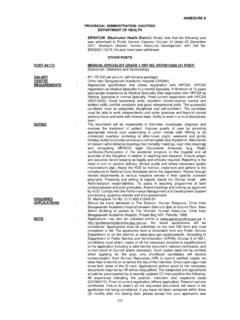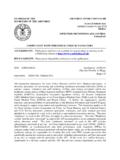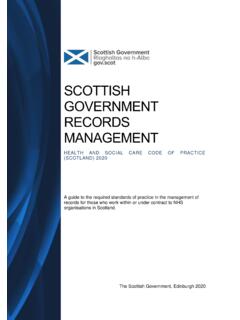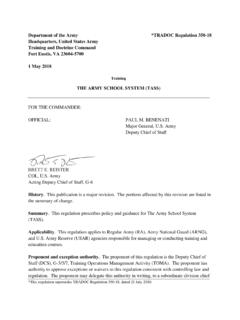Transcription of Medical Equipment Management - USAID Global Health …
1 1 FEDERAL DEMOCRATIC REPUBLIC OF ETHIOPIA MINISTRY OF HEALTHETHIOPIAN HOSPITAL SERVICESTRANSFORMATION GUIDELINESCHAPTER 15: Medical Equipment ManagementEthiopian Hospital Management InitiativeVersion , 2017 ETHIOPIAN HOSPITAL SERVICES TRANSFORMATION GUIDELINESiFEDERAL DEMOCRATIC REPUBLIC OF ETHIOPIA MINISTRY OF HEALTHETHIOPIAN HOSPITAL SERVICESTRANSFORMATION GUIDELINESCHAPTER 15: Medical Equipment ManagementEthiopian Hospital Management InitiativeAugust, 2017 Version 15 Medical Equipment ManagementiiForward The earliest modern efforts to improve the quality of government hospitals throughout Ethiopia began in 2006 with the Ethiopia Hospital Management Initiative (EHMI), envisioned by the then Minister of Health , Dr. Tedros Adhannon, and supported by the Clinton Health Access Initiative in collaboration with the Yale Global Health Leadership Institute.
2 The EHMI resulted in the creation of the Ethiopian Hospital Reform Implementation Guidelines (EHRIG), which built on both the Business Process Reengineering (BPR) and Hospital Blueprint efforts, as well as the Masters in Hospital and Healthcare Administration (MHA) degree program. Subsequently, the country developed a hospital performance monitoring system based on achievement of key performance indicators (KPI) and the Ethiopia Hospital Alliance for Quality (EHAQ) to spread best practices and promote collaborative learning in government hospitals nationally. EHAQ has focused on patient satisfaction, labor and delivery Management , and provides a national framework for continuous quality improvement in hospitals across Ethiopia. The Ethiopian Hospital Services Transformation Guidelines (EHSTG) build on and expand the Ethiopian Hospital Reform Implementation Guidelines (EHRIG) and are consistent with the Health Sector Transformation Plan (HSTP).
3 The EHSTG, which is consistent with the national focus on quality improvement in Health care, contains a common set of guidelines to help hospital Chief Executive Officers(CEOs), managers, and clinicians (care providers) in steering the consistent implementation of these transformational systems and processes in hospitals throughout the country. The EHSTG focused on selected Management and clinical functions, including new individual service specific chapters for Emergency Medical , Outpatient and Inpatient Services, Nursing and Midwifery, Maternal, Neonatal and Child Health and Teaching Hospitals Management . These guidelines also incorporate recent lessons from the operationalization of the EHRIG, as well as, new national initiatives such as the Guidelines for the Management of Federal Hospitals in Ethiopia, Hospital Development Army (HDA), Clean and Safe Hospital (CASH), and Auditable Pharmaceutical Transaction and Service (APTS).
4 ETHIOPIAN HOSPITAL SERVICES TRANSFORMATION GUIDELINESiiiIt is expected that the guidelines will continuously evolve as new evidence emerges regarding improved hospital care and practices that are better tailored to needs and circumstances of different tiers of public hospitals. We are grateful to all partners that have participated in the production of these guidelines. Special thanks go to our colleagues at the Clinton Health Access Initiative for their substantial contributions and support throughout the development of these guidelines as well as their dedicated efforts in support of our Health reform efforts in so many other capacities. Hon. Minister Kesetebirhan Admasu (MD, MPH) Minister of Health , Federal Democratic Republic of EthiopiaChapter 15 Medical Equipment ManagementivAcknowledgementsThe Federal Democratic Republic of Ethiopia Ministry of Health would like to acknowledge the following individuals and their organizations for their participation in technical working groups and contributions in the development of this Mideksa CHAI Dr.
5 Frehiwot Woldehanna AAU-AAIT. CBMB ereket Endrias FMOHD emeru Yeshitila JPIEGOW ondafrash Million FMOHM edical Equipment Management chapter proofreaders (Alphabetically listed)1. Lemlem Degafu Pharmaceutical and Medical Equipment Management directorate , FMOH2. Miraf Tesfaye Pharmaceutical and Medical Equipment Management directorate , FMOH3. Rahe Desta Pharmaceutical and Medical Equipment Management directorate , FMOHETHIOPIAN HOSPITAL SERVICES TRANSFORMATION GUIDELINESvTable of ContentsForward II Acknowledgments IVTable of contents VList of Tables VIList of Figures VIList of Boxes VIAbbreviations VIIS ection 1 Introduction 1 Section 2 Operational Standards for
6 Medical Equipment Management 2 Section 3 Implementation Guidance Medical Equipment Management Unit Medical Equipment Management Committee Medical Equipment Maintenance Workshop Medical Equipment Inventory 6 Equipment Risk Classification 10 Spare Parts Inventory Equipment History File 12 Model Medical Equipment List Medical Equipment Development Plan Accusation /Procurement of Medical Equipment Equipment Donation Preparing for Equipment Delivery and Commissioning Acceptance Testing and Installation Standard Operating Procedures Calibration, Inspection.
7 Testing and Maintenance Disposal of Medical Equipment Training in Equipment use and maintenance Budgeting for Medical Equipment Management 32 Budget Submission Medical Equipment Incident Reporting 35 Section 4 Implementation Checklist and Indicators Assessment Tool for Operational Standards Implementation Checklist Indicators 37 Chapter 15 Medical Equipment ManagementviSource Documents 39 Appendices 42 Appendix A Sample Inventory Data Collection Form 42 Appendix B Typical Equipment Lifespan 44 Appendix C Sample Medical Equipment Risk Assessment Form 49 Appendix D Sample Bin Record Card for Spare Parts 53 Appendix E Sample Stock Record Card for Spare Parts 54 Appendix F Common Site Preparation Steps for Installation of Medical Equipment 55 Appendix G Guidance for Unpacking and Inspecting Equipment Orders 57 Appendix H Sample Acceptance Test Log Sheet 59 Appendix I Sample Planned Preventive Maintenance Log Sheet 70 Appendix J Good Practice Checklist for
8 Corrective Maintenance 71 Appendix K Sample Corrective Maintenance Report 75 Appendix L Sample Work Order Form 76 Appendix M Sample User Training Verification Form 78 Appendix N Principles behind Replacement Cost Calculation 79 Appendix O Biomedical Equipment Maintenance workshop layout For General and Referral Hospital 80 Tables Table 1 Sample Template for Equipment Development Plan 14 Table 2 Steps to Develop an Equipment Training Plan 30 Table 3 Medical Equipment Management Checklist 36 Table 4 Medical Equipment Management Indicators 37 FiguresFigure 1 The Medical Equipment Management Cycle 2 Figure 2 The Hidden Costs of Medical Equipment Management 33 Boxes Box A Definition of Medical Equipment 8 ETHIOPIAN HOSPITAL SERVICES TRANSFORMATION GUIDELINESviiAbbreviationsAAMIA merican Advanced Medical InstrumentsACCE American College of Clinical EngineeringBMEB iomedical EngineerBMESB iomedical Engineering ServiceBMETB iomedical Equipment TechnologistBMTB iomedical Equipment Technician (level 4 & 5)
9 CEOC hief Executive OfficerCHAIC linton Health Access InitiativeCMMSC omputer Maintenance Management SystemEDPE quipment Development PlanFAMUF ixed Asset Management UnitFMOHF ederal Ministry of HealthHTHealthcare TechnologyHTA Healthcare Technology AssessmentHTMH ealthcare Technology ManagementLISLab Information SystemMECM edical Equipment CommitteeMEMUM edical Equipment Management UnitMSGDM edical Service General DirectorateNGONon-Government Organization PACSP icture Archive Communication SystemPHIDP ublic Health Infrastructure DirectoratePPMP lanned Preventive MaintenanceRHBR egional Health BureauRISR adiography Information SystemSOPS tandard Operating ProcedureTATechnical AdvisorTORT erms of ReferenceWHO World Health OrganizationETHIOPIAN HOSPITAL SERVICES TRANSFORMATION IntroductionThere is a recognition that Health technology Management , including Medical Equipment , is among areas included in the Healthcare Sector Transformation plan (HSTP) for the next 5 years (2015/16-2019/20(2008-2012 EFY)).
10 Specific areas that require improvement in the coming years include the development of local innovative healthcare technologies through technology transfer and increased local production Ethiopia, lack of proper Management of Medical Equipment has limited the capacity of Health institutions to deliver adequate Health care. It is estimated that only 72% of Medical Equipment found in Addis Ababa public hospitals are functional and in some hospitals in the regions functional Equipment are near to 50%. The rising number of these non-functional Equipment are due to Poor Equipment handling and utilization, frequent power surges, the age of the Equipment , lack of operator training, lack of preventive maintenance, lack of spare parts, lack of maintenance capacity, and minimal knowledge regarding sophisticated healthcare delivery continues to expand and improve in Ethiopia, and an increasing number of sophisticated Medical Equipment is introduced, a system capable of supporting and managing these Medical technology must be in place.










